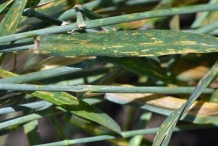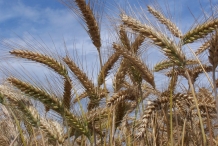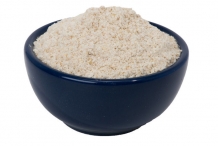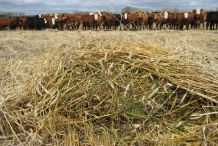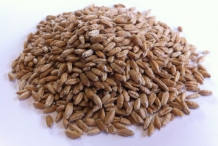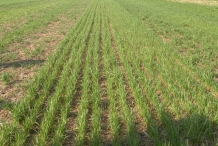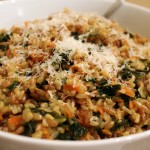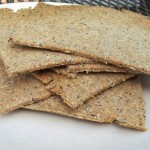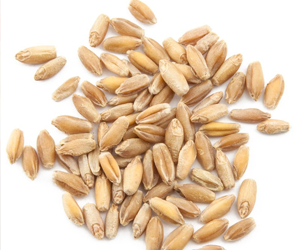 Triticale is actually a crossbreed of wheat (Triticum) as well as rye (Secale) first bred in a labratory in the late 19th century in Scotland and Sweden. Commercially accessible triticale is nearly always a second generation crossbreed, i.e., a cross between two types of major (first cross) triticales. Usually, triticale mixes the yield potential as well as grain quality of wheat together with the disease as well as environmental tolerance (which includes soil conditions) of rye. Just lately has it been developed into a commercially sensible crop. With respect to the cultivar, triticale can pretty much appear like either of its parents. It really is cultivated mainly for forage or even fodder, even though some triticale-based foods can be bought at health food stores or even are to be obtained in a few breakfast cereals.
Triticale is actually a crossbreed of wheat (Triticum) as well as rye (Secale) first bred in a labratory in the late 19th century in Scotland and Sweden. Commercially accessible triticale is nearly always a second generation crossbreed, i.e., a cross between two types of major (first cross) triticales. Usually, triticale mixes the yield potential as well as grain quality of wheat together with the disease as well as environmental tolerance (which includes soil conditions) of rye. Just lately has it been developed into a commercially sensible crop. With respect to the cultivar, triticale can pretty much appear like either of its parents. It really is cultivated mainly for forage or even fodder, even though some triticale-based foods can be bought at health food stores or even are to be obtained in a few breakfast cereals.
Whenever crossing wheat as well as rye, wheat is utilized as the female parent as well as rye as the male parent (pollen donor). The resulting hybrid is sterile, and should be cured with colchicine to stimulate polyploidy and therefore the opportunity to reproduce itself. Its name comes from the Latin names for wheat – Triticum and rye – Secale. This particular crossed breed has even more health advantages compared to its parents and much more nutrition, vitamins, minerals, anti-oxidants etc. 100 grams of triticale consists of 336 calories.
Food science has been an essential area of science for several years, and one of the very most fascinating developments came in the late 19th century, whenever scientists bred wheat as well as rye together, that are two of the most significant cereal/grain staple foods in the world, to create triticale. The results were simply impressive. The intention was to obtain the best yield and quality of wheat with all the disease tolerance and different nutritional composition of rye. What they discovered was that triticale actually has higher levels of most vitamins and minerals compared to either of the two contributing species, which makes it a perfect dietary fodder food for livestock. Lately, however, it has become a well known health food for human beings, also because of the fact that it is filled with beneficial nutrition. Triticale is often present in numerous health cereals, and may additionally be present in a variety of forms, possibly as the whole triticale berries, flour, cereal, bread, flakes, or crackers.
In spite of its incredible health advantages as well as nutrient-packed nature, triticale is just manufactured in 29 nations all over the world and also the total harvest yield is 15 million tons, that is dwarfed by the totals for additional traditional grain crops. Certainly, the breeding process is a little more complicated, making the initial production a little more expensive, but when a stable hereditary line is put in place, it really is simply the same cost as any other grain crop. The key producers of triticale are Poland, Australia, Germany, and France. Scientific studies are ongoing to boost the development as well as nutritional content of triticale. For now, let’s think about the nutritional content which makes triticale so valuable as well as healthy.
Health Benefits of Triticale
A few of the health advantages of triticale consist of its capability to enhance digestive effectiveness, enhance heart health, boost healing and metabolic rate, enhance energy levels, safeguard infants in the womb, helps prevent and controls diabetes, boost circulation, prevent asthma, decrease numerous skin disorders, as well as bring about strong bones.Listed below are some popular benefits of consuming Triticale:
1. Diabetes Control
For all those individuals struggling with diabetes or in danger of developing the condition, triticale might help in a number of ways. First of all, the high fiber content of triticale (50% greater than wheat or rye) suggests that blood sugar levels are well balanced, that is the main issue for diabetes sufferers. The bloodstream is overloaded along with simple sugars as well as glucose which in turn causes main difficulties; thankfully, fiber helps prevent this. Secondly, the large content of manganese present in triticale is a second line of defense for diabetics. Manganese is really a functional part of various enzymatic processes in gluconeogenesis, that is how the human body turns sugars into fuel, instead of absorbing it in the bloodstream. This gives us with increased energy and much more managed amounts of blood sugar levels.
2. Digestion
As stated before, triticale is an extremely essential source of dietary fiber (19 grams per cup), that makes it extremely effective when it comes to human digestion. Dietary fiber helps you to bulk up stool, pass food from the digestive tract quicker, as well as accelerate the entire process of absorption as well as excretion. Which means that any kind of toxins within the bowels are removed faster, and in addition it boosts effectiveness of nutrient absorption, making room for additional food (and therefore, much more nutrition). High fiber diets help to reduce constipation, diarrhea, bloating, cramping, along with other intestinal problems, even more serious ones just like Crohn’s disease, gastric ulcers, and also colon cancer.
3. Circulation Boost
Red blood cells are important elements in human health, since they provide the oxygen to all areas of the body, which includes vital organ systems, skin cells, and muscle tissues. Iron, copper, and folic acid are all required elements within the manufacture of red blood cells, and triticale has all three of these in substantial levels. Which means that RBC count as well as circulation increases, therefore enhancing the speed of healing of numerous tissues and cells, enhancing metabolic effectiveness, increasing hair growth, as well as offering the body along with well balanced levels of energy.
4. Cell Production
Just like fiber, triticale features a greater content of protein compared to possibly wheat or rye. Which means that cell production through the body could be elevated, metabolic as well as enzymatic processes could be optimized, and also general bodily functions could be much more effective. Proteins are definitely the building blocks of cells, since they can be broken down in their component amino acids after which re-structured into whatever materials our body needs to stay healthy. Together with protein, triticale also includes manganese, folic acid, along with a number of other nutritional elements that are crucial for cell production.
5. Bone Health
Triticale is surely an amazing source of minerals, a few of which perform a huge role in the manufacture of bone tissue. Zinc, phosphorous, calcium, as well as manganese are all essential parts of bone production as well as power within the body. Individuals with fragile bones or even aging people who are going through age-related bone degradation would do well to include triticale on their diet, as it can certainly considerably enhance bone growth, speed u p bone healing, and stop conditions just like osteoporosis.
6. Asthma and Skin Conditions
The highest content of minerals present in triticale is manganese, and while this isn’t always probably the most discussed mineral within our diet, that is certainly a strong one in these quantities. There is a lot more than 300% of the every day suggested consumption of manganese in one serving of triticale. Manganese acts numerous functions, as currently explained, but it also is really a co-factor in manganese superoxide dismutase, that is a effective antioxidant. Higher amounts of manganese and also this enzyme have already been linked to a decrease in oxidative stress conditions, which includes asthma and various skin disorders.
7. Pregnancy Protection
Triticale may also help safeguard pregnant moms. Higher amounts of folate help safeguard the unborn baby from developing neural tube defects at birth. Higher amounts of folate additionally make certain that mother as well as her unborn baby don’t create a folic acid insufficiency. Triticale, with its high folic acid levels, is a perfect food source for safeguarding expectant mothers.
Recipe of Triticale
1. Triticale Biscuit
Ingredients
- 1/2 cup Triticale Flour
- 1/2 cup Whole Wheat Flour
- 2 1/4 tsp Baking Powder
- 2 tbs Milk Powder (Non-Fat Dry)
- 2 tbs Vegetable Shortening
- 1/3 cup Water
- 1/2 tsp Sea Salt
Cooking Directions
- Preheat oven to 425. One ungreased cookie sheet, set aside.
- Sift dry ingredients together. Cut in shortening. Add water, stir quickly. Knead for 1 minute and roll dough 1 inch thick and cut into biscuits. Put biscuits onto cookie sheet as well as bake for 10-15 minutes.
- Yield: 9 biscuits.
2. Triticale and Squash Risotto
Ingredients
- 2 cups triticale berries, soaked for around 8 hours and drained thoroughly
- 1 tablespoon butter, melted
- 1 medium butternut, acorn or delicata squash, peeled, seeded and diced
- 2 x 14-1/2-ounce cans chicken broth
- 1/4 cup water
- 1 tablespoon olive oil
- 1 1/2 cups chopped onions
- 1 tablespoon finely chopped garlic
- 1/2 cup white wine
- 3/4 pound winter greens (kale, chard, collards), trimmed and leaves chopped
- 1 teaspoon chopped fresh thyme
- 1/2 teaspoon salt
- 1/4 teaspoon freshly ground pepper
- 1/8 teaspoon freshly ground nutmeg
- 1/3 cup freshly grated parmesan cheese
Cooking Direction
Heat oven to 425 degrees F. Cover triticale with fresh water as well as boil for 20 minutes. Drizzle melted butter over squash on the jelly roll pan; toss. Bake 25-35 minutes or until tender and browned. Bring broth and water to the simmer in the saucepan. Heat oil over medium-high heat in the large pot; add onions and cook 4-6 minutes or until tender and lightly browned. Add garlic and cook 1 minute. Add wine and cook 1 minute more. Stir in drained triticale and cook until wine is assimilated. Reduce heat to medium and gradually add broth mixture half a cup at a time, stirring, till liquid is soaked up and triticale is tender, 12-17 minutes. Stir within the squash, greens, thyme, salt, pepper and nutmeg; cook, stirring, 4-5 minutes or till greens are tender. Stir in grated parmesan. Serve immediately. Makes 6 servings.
3. Kale & Triticale Risotto
Ingredients
- 1/2 pound Nash’s triticale berries
- 1 bunch lacinato kale leaves, ribs and stems removed
- 1 tablespoon extra virgin olive oil, divided
- 2 cups veggie or chicken broth
- 1 medium shallot, sliced
- 1/2 tablespoon butter
- 2 cloves garlic, sliced
- 3 ounces Parmesan cheese
Cooking Direction
Wash and soak berries overnight. Cook as you might rice (1 part grain, 1 1/2 part water) for around 1 hour or till tender. Drain and coat along with some olive oil.
Coarsely chop kale and reserve. In big sauce pan, warm oil on medium heat and add shallot. Cook about 2 minutes, then add kale and wilt together for 2 minutes, then add garlic. Saute 30 seconds, stirring occasionally, then add broth and simmer about 10 minutes or till broth is usually absorbed. Add butter, Parmesan cheese and cooked triticale. Add salt and pepper to taste. Garnish with chives and much more Parmesan cheese if desired.
4. Triticale-Chia Cracker Recipe
Ingredients
- 2 cups triticale flour
- tsp sea salt
- 1 tsp baking powder
- 1/3 cup chia seeds
- 1 tsp ground black pepper
- 4 tsp olive oil
- ¾ – 1 cup lukewarm water
Cooking Direction
Preheat oven to 350 degrees Fahrenheit. Stir the flour, salt, baking powder, chia seeds, as well as pepper together in the large bowl. Add some olive oil and ¾ cup water. Mix to include all ingredients, adding more water if required for dough to hold together. Knead a few times until dough is smooth. Let sit for Ten minutes. Grease two big cookie sheets or even jelly-roll pans. Divide dough in half. Utilizing a rolling pin, roll dough to cover each cookie sheet, rolling dough as thin as possible. Prick dough all over with a fork and cut into preferred size using a pizza cutter. Bake for 20 minutes or even till crackers are golden brown. Take away from oven, let cool. Break into individual crackers and store in a sealed container.
5. Hopping Nash Fritters
Ingredients
- 1 cup Nash’s dried fava beans, blanched
- 1 cup triticale berries, cooked
- 2 cups dried black-eyed peas, cooked
- 1 pound Nash’s sweet Italian sausage
- 1 medium onion
- 1 bunch parsley
- 1 teaspoon salt
- 1 teaspoon pepper
- 1 bunch purple radishes
- 1 teaspoon or less cayenne pepper
- Bread crumbs
Cooking Direction
Soak fava beans overnight in 2 cups water, drain and cook for 45 minutes to 1 hour. Soak triticale overnight in 2 cups water, drain and cook in 1 1/2 cups of water for 45 minutes to 1 hour. Soak black-eyed peas overnight in 4 cups water, drain and cook in 3 cups water for around 1 hour on medium heat.
Saute pork in medium skillet, add chopped onion, chopped parsley, salt, pepper and sliced radishes. Let cook for around 15 minutes on medium heat. Once the sausage turns golden brown, turn off heat and let cool.
Drain cooked berries and black-eyed peas (make certain there isn’t any liquid on bottom of cooking dish). Let cool.
In a separate bowl, combine triticale berries, black-eyed peas and sausage combo. Mash together just so the beans start to break apart. Add fava beans and cayenne pepper. Mix all together and form patties. Add some bread crumbs so that they hold together well. If you want a gluten-free option add a bit of almond meal and it will behave as a binder. Pan fry and enjoy the good luck that local foods bring to your table.
6. Pork and Cabbage Raab Stirfry
Ingredients
- Several slices bacon or pork belly
- 4 cloves garlic, chopped
- 2 bunches cabbage raab (or other raab), bottom ends trimmed
- Dash olive oil
- Salt and pepper to taste
- Cayenne to taste (optional)
- Brown rice or cooked whole grains
Cooking Direction
Cut several slices of bacon or pork belly into small pieces and sauté with garlic in the frying pan till the bacon begins to brown. Remove and set aside.
Wash raab and trim off the bottom ends. Cut the rest-stalk, leaves, florets and all-into 1-inch pieces. Add a little olive oil to the pork drippings and sauté the raab until it begins to wilt. Cover and allow it to cook for some minutes more until tender.
Remove from heat and stir in pork and garlic. Add salt and pepper to taste, along with a little cayenne if you’d prefer a bit of a kick. This tastes great on a bed of brown rice, or on cooked whole grain, like triticale or rye berries.
A Final Word of Caution
Triticale, just like wheat and rye, include higher amounts of gluten, so those who have problems with gluten intolerance or allergies, like Celiac disease, need to avoid triticale and try other non-gluten health cereals that won’t cause serious allergy symptoms and intestinal problems.


